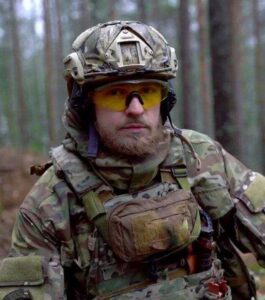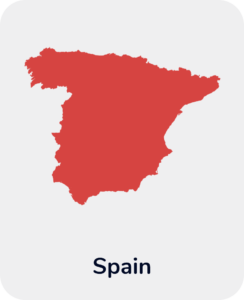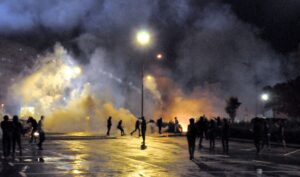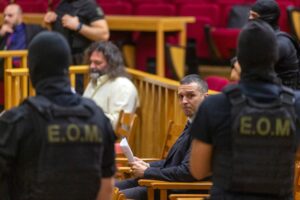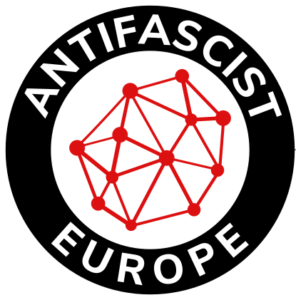This article is part 3 of 7 in the Hammerskins Series. This series was originally published in German via Exif – Recherche & Analyse, and gives us an in-depth look into one of the oldest and most stable neo-Nazi organisations worldwide. This is the third part of the series and gives a detailed account and explanation of their engagement in criminal activities, such as murder and terror attacks.
Part 1 of this series draws a larger picture of the network, its history, and its organisational infrastructure. Part 2 explains the identity of Hammerskins and its members, their rules and codes, as well as symbols and visuals they deploy. All their activities are funded via multiple streams of revenue, which Part 4 analyses. Part 5 sheds light on the role of Hammerskins in the ‘NSU Complex’. Part 6 delves into the transnational aspect of the organisation and associated problems they face because of it. The final part of the series, Part 7, focuses on the failure of German intelligence services to identify Hammerskins as an influential actor within right-wing extremism in Germany and worldwide. One central goal of this series is to drag Hammerskins workings out of the shadows and give possibility to the developing of counter-strategies, which so far seemingly has not happened.
Racially motivated brutal attacks, manslaughter and murder are commonplace throughout the 30-year history of the Hammerskins. Many members have been convicted for assault, illegal firearms possession or similar offences.
The “Hammerskin Nation” (HSN) sees itself as the elite organisation of the neo-Nazi skinhead scene and considers itself at the forefront of an ongoing “race war”, preparing for the upcoming “final battle”—the neo-Nazi D-Day (in Germany referred to as “Day X”). They are inspired by the ‘leaderless resistance’ strategies of terrorist groups from the 1980s.
Thanks to the HSN’s global network—and its principle of absolute secrecy and loyalty—members and those close to the network are able to share and exchange their expertise and, for example, to obtain weapons or organise escape routes and hideouts in foreign countries.
Terror concepts drawn from the motherland of the brotherhood
Hammerskin publications have repeatedly written about launching right-wing terror attacks, making references to actual terrorism cases and perpetrators.
For US skinheads, the novel The Turner Diaries was considered compulsory reading at one point. Written under the pseudonym Andrew Macdonald in 1978 by the US neo-Nazi William Luther Pierce, who died in 2002, the novel elaborates on the leaderless resistance concept of terror. In the book, Pierce introduces a racist group called ‘The Organisation’ that has rallied around the protagonist Earl Turner. Having gone underground, the group commits targeted killings, bombings and acts of sabotage.
An article in the tenth issue of the Hammerskins Berlin publication Wehrt euch! from 1999 discussed the novel: ‘We won’t reveal how the whole thing ends, we still want you to want to read this book.’ The ‘final battle’, in which all enemies are destroyed, is a recurring motif in the HSN’s self-presentation. For example, a line in the 2006 song Hammerskins by the Bremen band “Hetzjagd” reads: ‘Hammerskins, the elite rooted among the masses (…) in the fight for our white race, we are nationalists from all over the world, our brotherhood holds us together forever. Until the last of our enemies’ final fall.’
The Order – Brothers Keep Silent
One group in the 1980s US that attempted to implement the concepts of the Turner Diaries was The Order (aka Brothers Keep Silent or Brothers’ Silence). The head and founder of The Order, the Texan Robert Jay Mathews, is said to have known the Turner Diaries by heart. Mathews’ group was involved in bank robberies, bombings and murder. They went into hiding and never claimed responsibility for their crimes.
Imprisoned members of The Order – Brothers Keep Silent enjoy almost cult status among Hammerskins and frequently receive financial support. For example, in November 1988, the Hammerskins Saxony and the Romandie Hammerskins (Switzerland) jointly organised a Robert Jay Mathews Memorial concert in the state of Saxony, Germany. Forrest Hyde, the founder of the Hammerskin Nation in the US was present at the concert.
In 2000, the Hammerskins Mecklenburg published an interview with the imprisoned The Order member Richard Scutari in the publication The Crossed Hammers. Another member of The Order, David Eden Lane, authored the so-called 14 Words, which state: ‘We must secure the existence of our people and a future for White children.’ Acting in accordance with the 14 Words became a statute of the Hammerskin Constitution, written towards the end of the 1990s and still adhered to by the “brothers” worldwide.
André Eminger, a defendant in the NSU trial, wore a T-shirt that displayed the phrase ‘Brothers keep silent—until death’ while Thomas Gerlach, a member of the Hammerskins Saxony, testified in court. It was an effective message: neither did Gerlach make any incriminating statements, nor did he respond to any questions about the Hammerskins.
The “boss” as the propagandist of the underground and terror
Malte Redeker, who has been the European Secretary of the Hammerskin Nation since the late 2000s, is undoubtedly one of the most influential European Hammerskins. The website of Redeker’s music label Gjallarhorn Klangschmiede/Frontmusik prominently features a collage in memory of Robert Jay Mathews. Redeker seems obsessed with The Order and its members. He even has a portrait of Mathews tattooed on his back.
In 2012, Redker launched a campaign to raise funds for Gary Lee Yarbrough. Yarbrough was a member of The Order – Brothers Keep Silent and was serving a prison sentence for his activities in the terrorist group. In the year 2000, in the neo-Nazi fanzine Der Braune Bär, Redeker also commented on the right-wing terror group Combat 18 (C18): ‘Absolutely worthy of support. […] Actions count more than words. Whatever it takes!’ […] Leaderless resistance is our motto.’
At an event of the right-wing martial arts format Kampf der Nibelungen in East Saxony in November 2019, Redker explained on stage why the far-right scene needs martial arts: ‘(…) it’s psychologically important and increases our power on the streets. Martial arts are good for self-confidence, to be physically fit, and these skills will be needed to defend ourselves on the D-Day [in German: ‘Day X’] we are yearning for.’ (sic!)
Patrick Schröder, with his extreme right-wing YouTube channel FSN-TV, presented a programme on the US-American Aryan Republican Army (ARA) terrorist group in November 2012. ARA member Scott Stedeford was sentenced to 30 years in prison for various bank robberies in 1996. Redeker had kept in touch with him and explained to Schröder on FSN-TV that he had conducted two interviews with Stedeford. Redeker was ‘very much in awe’ of the fact that Stedeford ‘remained steadfast’ and ‘accepted the sentence of 60 years of imprisonment with a smile’. Even while serving his sentence, Stedeford continued to produce music. He is said to have provided his material to Dennis Dent, an ex-Hammerskin and the singer of the US neo-Nazi band “H8 Machine”. Any proceeds would flow back to Stedeford. In 2016, the CD Fighting Solves Everything by “H8 Machine”, produced by Redeker on his Gjallarhorn Klangschmiede/Frontmusik label, was released.
The US as a role model
According to the bylaws of the German Hammerskins, every (future) member must visit the “brothers” in the US at least once. Such visits usually take place during the annual Hammerfest, which is organised by the HSN in different states. The “brothers” in the US are admired for their toughness and determination.
In April 2017, Redeker forwarded a request from the Western Hammerskins (WHS) to the European Hammerskins chapters. After spending 19 years in prison, Travis Miskam was about to be released. As a member of the WHS, Miskam would be delighted to receive the support of every single chapter worldwide, the US Hammerskins wrote.
Miskam was part of a mob that had attacked and seriously injured Randy Wordell Bowen on racial grounds in Temecula, California, on 17 March 1999. Bowen survived the stabbing attack, as the knife barely missed a vital organ. Miskam was considered the leader of the local Hammerskins chapter at the time. The list of examples of such attacks in which US Hammerskins have played a decisive role since the HSN’s founding generation tried to violently establish no-go areas for people of colour in the city centre of Dallas (Texas) at the beginning of the 1990s is long. It includes, for example, the racist murder of Donald Thomas in June 1991 committed by Christopher Brosky and two other Confederate Hammerskins members in Arlington (Texas); or the case of Douglas Garret, a homeless black man who was beaten to death by Lois Oddo and another Hammerskin in Birmingham, Alabama, in December 1991.
Another similar case was that of Michael Boyd, a member of the Confederate Hammerskins, who shot a black man on the outskirts of Dallas (Texas) in May 1995. A Hammerskins fanzine from the 1990s printed a request by “Hammerskin P.O.W.” Michael Ray Perry for people to write him letters. He was in prison and had been convicted of murdering ‘three SHARPs’.
It is this image of the scene in the US that fascinates Hammerskins from other countries and turns them into potential murderers, imagery which is additionally amplified by shooting practice events that are undoubtedly part of any visit to the United States—and which are held in ways that would be inconceivable at shooting ranges in Germany.
When the musician and former Hammerskin Rene Weiße visited the US in 2002, he told a “brother” about a ‘coyote hunt’ in which people were also shot at. Up until 2019, Weiße was the singer of the band Brainwash, one of the world’s most influential neo-Nazi hardcore bands. On an album released in 2004 on Malte Redeker’s Gjallarhorn Klangschmiede label, one song includes the following lyrics: ‘To the ARA and The Order, we show our reverence!’ You can only hear the names of these US terrorist groups, however, while they have been intentionally omitted in the booklet, as is the list of names of members of The Order, which are read out by Weiße at the end of the song. The band’s bassist Michael Lorenz used the alias Earl Turner—a reference to the protagonist of the Turner Diaries.
Oak Creek, Wisconsin, August 2012: A Hammerskin murders seven people
On his trip to the US in October 2010 Malte Redeker was accompanied by Hendrik Stiewe. At the Hammerfest in Detroit, Michigan, they met up with Wade Michael Page, who received his prospect patch there. A year later, at the Hammerfest in Florida on 11 October 2011, he would become a full member of the Confederate Hammerskins.
Page had been an active musician in various right-wing rock bands since the 1990s. In 2002, for example, he joined the Hammerskin band “Intimidation One” for their European tour, during which he also met German Hammerskins.
On 5 August 2012, Wade Michael Page stormed a Sikh temple in Oak Creek in the US state of Wisconsin and opened fire with a pistol. Six people died, and four were seriously injured, of whom one later died.
A few days after the attack, in a closed online forum, Hendrik Stiewe complained about interview requests. Before the attack, he had produced the re-release of the CD Welcome to the South by Page’s band “Definite Hate” on his Wewelsburg Records label. Stiewe’s close ties to the Confederate Hammerskins and thus to Wade Michael Page are also revealed in a travel report for the fanzine Für immer und ewig published in the German state of Saxony.
When Redeker learned of Page’s killing spree in Wisconsin, he immediately warned his “brothers” in Europe and gave them specific instructions. The administrator of the Hammerskin forum was ordered to delete all of Page’s posts. Also, the “brothers” were not to officially sympathise with the crime and were told to ‘not talk about the incident’. In addition, no one was allowed to talk about it on the phone either.
For the HSN, the attack entailed no consequences.
Murders committed by German Hammerskins
On 29 August 1992, the neo-Nazis Norman Zühlke and Hendrik Jähn were on a playground in the Berlin district of Charlottenburg. They insulted and harassed a group of four students from Sri Lanka until Günter Schwannecke, an artist, and his friend Hagen K. came to the aid of the group that was attacked.
Zühlke rushed home, got a baseball bat and brutally assaulted them both. Hagen K.’s life was saved in hospital, Günter Schwannecke died from his injuries on 5 September 1992.
After his early release from prison, Zühlke joined the Hammerskins. As early as 1997, he edited the Hammerskins Berlin magazine Wehrt euch! (Defend yourselves!). From 1998 onwards, he was in charge of mailing the monthly newsletter of the Berlin chapter to the European “brothers”. In April 2002, the police searched the homes of Zühlke and other Hammerskins, after accusing them of complicity in the distribution of a banned CD. This case was also dropped.
From the early 1990s until its dissolution in 1998, Patrick Cuhrts was among the key figures of the original Hammerskins Brandenburg chapter. According to police investigations, Cuhrts, together with André B., Marco Z. and Marcel St., had committed aggravated assault resulting in death on 30 June 1995 in the small town of Jüterbog.
They all belonged to the group surrounding Cuhrts and had been identified as Hammerskins Brandenburg members by police in 1995. An article in the Märkische Allgemeine Zeitung (MAZ) of 3 July 1995 provides further information: ‘Three people were injured in a brawl in a youth club on Friday evening [30 June 1995, author’s note] in Jüterbog (Teltow-Fläming district). (…) At about 9.40 pm, a group of between ten and twelve young people aged 17 to 23—including two girls—got into an argument during an evening dance event. The argument developed into a brawl, during which the manager of the youth club and two guests were injured after receiving punches and kicks.’
The article is a harrowing account from a time that is now quite rightly known as the so-called “baseball bat years”. The article’s subheading “Brawl in youth club” trivialises what actually happened. To this day, this episode, in which neo-Nazis beat up a person so severely that he died, has resulted in little more than a newsflash next to reports on swimming accidents.
On 6 October 1999, 38-year-old Kurt Schneider was murdered by four neo-Nazis in Berlin’s Lichtenberg district. The night before, the Berlin-based neo-Nazis Michael Voigt, Manuel Sandmann, Carsten Ufer and Björn Oberjartel had met and walked to a house occupied by left-wing squatters.
On the way, they hit a youth on the head with a beer bottle because he was eating a kebab and looked ‘like a hip-hopper’. When they reached the squat, they began to chant: ‘Here marches the national resistance.’ Then they went to buy beer. On their way, they encountered Kurt Schneider, who hollered ‘Cheers, comrades!’ at them as they passed. The neo-Nazis felt provoked, being greeted by someone they perceived as ‘socially weaker’, and began to physically and verbally abuse him.
Schneider apologised and invited his attackers to drink with him. But the neo-Nazis lured him into a park, beat him up and robbed him, only to return with a kitchen knife and kill him shortly afterwards. Sandmann was a member of the Kameradschaft Spreewacht, which was closely linked to the Hammerskins Berlin until the 2000s. All four neo-Nazis self-identified as Hammerskins. Police searches found a Hammerskins Berlin T-shirt at the home of one of the four.
On the night of 9 to 10 April 2011, about 70 neo-Nazis attended a social gathering in a garden belonging to an NPD party official in Winterbach in Baden-Württemberg’s Rems-Murr district. Later that night, some of them started arguing with and racially abusing nine people who were in a garden nearby. The neo-Nazis chased them and beat them up. Five of those attacked fled into a garden shed, which the neo-Nazis set on fire. At the last second, the young men managed to escape into the open. Patrick Mörsdorf from the state of Saarland was sentenced for participating in this attack. He was already involved in Hammerskin structures at the time and is now a full member of the Westwall chapter. Two other neo-Nazis, Christian H. and Sebastian Sch., were also involved in the Winterbach trial. Sch. is today a full member of the Hammerskins Württemberg.
The Hitler quote, the ‘struggle is the father of all things’, often referenced in HSN music, is an elementary principle of the far-right and describes an essential characteristic: their ideology can only be implemented with (armed) violence. Hammerskins have repeatedly put this into practice.
